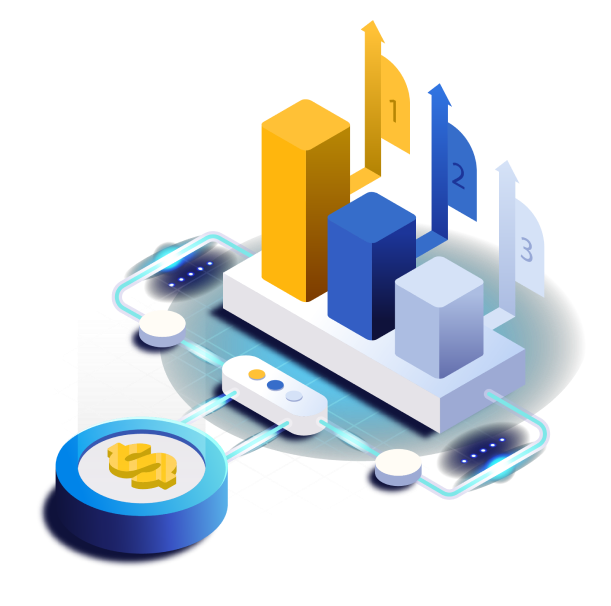- BI Services
- Advanced Data Analytics
Mastering the Art of Data: Advanced Analytics for Strategic Success"
- Advanced Analytics is effectively increasing the value of all the plans of action, by utilizing measurements and helping in choosing the best available option to increase the profits. It is likewise being utilized to crunch past information and using it to anticipate unfavorable circumstances and in turn avoiding them.
- An increasingly detailed examination of this information can truly help in setting a stable work process. BIITS can see that our lives are much less demanding as compared to how it was 10 years ago, and this is a direct result of Data Analytics.
- Data Analytics has truly reduced the gap between fiction and innovation. Right from Facebook to YouTube, the science of data analysis is being utilized all over. Applying Powerful Insight & Innovation to Gain the Competitive Edge High-performing companies frequently rely on having an intrinsic capacity, to settle on convenient and key choices with the available data to make timely & strategic decisions based on a vast array of detailed information.
- Numerous top companies have realized the characteristic esteem bolted inside their current data conditions and have made a shift towards a culture dependent on applying analytics to settle on more intelligent choices and decisions. With a team of highly qualified data scientists and analysts, we touch every possible boundary and illuminate the path to growth through our unique analytical capabilities.
- Every organisation organization needs to reap the actual benefits of advanced analytics. This can only be done by bringing static data to life through Business Intelligence, predictive analytics, Artificial Intelligence (AI), machine learning, and cognitive computing to build competitive advantage, faster decision-making abilities, improved efficiency, and increased customer retention. Advanced analytics enables you to:
-
- Increase in profits.
- Understand customers.
- Optimize experiences.
- Boost marketing effectiveness and ROI.
- Identify new revenue sources.
- Enhance customer satisfaction.
- Improve call centre center personalization.
- Shift to predictive everything.
- Improve employee retention.
- Reduce equipment outages.
- Minimize fraud loss.
- Improve forecasting
Benefits of choosing BIITS for your data Analytics services
Informed Decision-Making: Extract actionable insights from complex data, guiding smarter decisions and strategic initiatives.
Future-Proofing: Harness predictive analytics to forecast trends and behaviors, allowing for proactive strategy adjustments and risk management.
Dynamic Data Visualization: Convert complex data into clear, interactive visualizations, simplifying comprehension and effective communication.

perational Optimization: Uncover inefficiencies and streamline processes through pattern recognition, resulting in enhanced productivity and cost reductions.
Strategic Edge: Utilize advanced analytics to gain a comprehensive understanding of market trends and customer preferences, giving your business a competitive edge.
Frequently Asked Questions
Why use Advanced data analytics?
The potential of advanced analytics is enormous for companies searching for more data-driven decision-making capabilities: collecting more knowledge that offers more insight and can even predict the future.
However, as many businesses learn as they start developing their capabilities, it is not possible to develop a successful advanced analytics strategy overnight. It needs a base for conventional analytics and the ingestion of data.
Developing a plan for organizational analytics begins with knowing the degree of professionalism of the existing analytics activities. If you determine your level of professionalism in analytics, you can smash through the stumbling blocks to gain the next level of insight from your results.
How important is it to have the data for the analysis?
The first thing to consider is that the word “data lake” will not usually be used to characterize a specific product or service, but rather an approach to the design of big data that can be summarized as store now, analyze later. In other words, we would use a data lake to store unstructured or semi-structured data in its original form, in a single repository that serves multiple analytical use cases or services, unlike the traditional data warehouse approach, which involves imposing a structured, tabular format on the data when it is ingested.
What really is the correct time to deploy an analytics plan for me?
The first thing to consider is that the word “data lake” will not usually be used to characterize a specific product or service, but rather an approach to the design of big data that can be summarized as store now, analyze later. In other words, we would use a data lake to store unstructured or semi-structured data in its original form, in a single repository that serves multiple analytical use cases or services, unlike the traditional data warehouse approach, which involves imposing a structured, tabular format on the data when it is ingested.

Not sure how to use your company's data to your advantage?
Advanced data analytics because the information can convey a lot more insights than you think.
